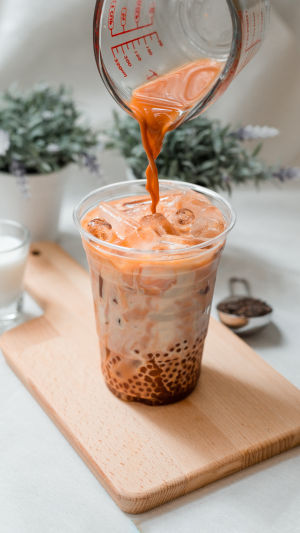In the vibrant tapestry of Southeast Asian cuisine, one delightful beverage stands out for its unique texture and sweet, creamy taste: Milk Tea with Sago.
This simple yet delicious drink combines the rich flavors of milk tea with the chewy, gelatinous pearls known as sago, offering a refreshing experience that has captivated the hearts of many across the region and beyond.
Let's dive into the world of sago, uncover its origins, and explore the popularity of Milk Tea with Sago in various countries.
<h3>What is Sago?</h3>
Sago is a starch extracted from the pith of various tropical palm trees. It is processed into small, translucent pearls that are a staple in many Asian and Pacific cuisines. When cooked, sago pearls become chewy and slightly elastic, making them a popular ingredient in desserts and beverages. Their neutral flavor allows them to absorb the rich, creamy taste of milk tea, creating a perfect balance of texture and taste in every sip.
<h3>Origins and Fame</h3>
While the precise origins of Milk Tea with Sago are debated, it's widely acknowledged that the concept of adding tapioca pearls (a similar ingredient to sago) to milk tea originated in Taiwan in the 1980s. The idea quickly spread across Asia, with each country adding its unique twist to the beverage. In Southeast Asia, sago was a natural choice due to its availability and cultural significance, leading to the birth of Milk Tea with Sago as we know it today.
This delightful drink enjoys immense popularity in countries like the Philippines, Thailand, Malaysia, and Singapore. Each of these nations has embraced Milk Tea with Sago, incorporating local flavors and variations that reflect their culinary traditions.
<h3>The Market for Milk Tea with Sago</h3>
The market for Milk Tea with Sago has seen exponential growth over the past few decades. Its popularity among young people, coupled with the rise of social media, has transformed it from a simple beverage into a cultural phenomenon. Today, countless milk tea shops across Southeast Asia and the world offer their take on this classic drink, with options ranging from basic Milk Tea with Sago to more elaborate versions featuring additional toppings like fruit jellies, aloe vera, and grass jelly.
<h3>A Traveler's Delight</h3>
For travelers exploring Southeast Asia, trying Milk Tea with Sago is an essential experience. Here's why you shouldn't miss out on this beverage in some key destinations:
Philippines: Known for its love of sweet treats, the Philippines offers a wide variety of Milk Tea with Sago flavors, including local favorites like ube (purple yam) and buko (young coconut).
Thailand: Thai Milk Tea with Sago combines the country's signature orange-colored tea with the chewy texture of sago, creating a visually appealing and delicious drink.
Malaysia: Here, you can enjoy a unique version of Milk Tea with Sago flavored with gula melaka (palm sugar), adding a rich, caramel-like sweetness to the drink.
Singapore: In this melting pot of cultures, Milk Tea with Sago is often enjoyed alongside a diverse array of local snacks, making for a perfect mid-day treat.
Milk Tea with Sago is more than just a beverage; it's a cultural icon that embodies the rich culinary heritage and innovation of Southeast Asia. Its simple ingredients, combined with the diverse range of flavors and textures, make it a must-try for anyone visiting the region. Whether you're strolling through the bustling streets of Manila, exploring the vibrant markets of Bangkok, relaxing in a café in Kuala Lumpur, or enjoying the scenic views of Singapore, a cup of Milk Tea with Sago is the perfect companion to enhance your travel experience.
So, the next time you find yourself in Southeast Asia, remember to indulge in a refreshing cup of Milk Tea with Sago. It's not just a drink; it's a taste of the region's warm hospitality and rich culinary traditions, waiting to be savored one sip at a time.





